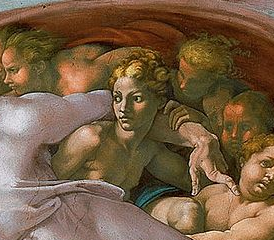What is the unheard story of the Sistine Chapel? Art historian Elizabeth Lev intends to tell us, taking us on a tour through Michelangelo’s series of frescos and what she considers “the great theater of life.”

The Sistine Chapel ceiling. (Public Domain)
Against the backdrop of Columbus’s voyage to the Americas, an age of exploration, Michelangelo took on the Sistine Chapel at the age of 33, commissioned by Pope Julius II in 1508. 133 by 46 feet with a 62-foot ceiling, the chapel was a vast undertaking, even despite the earlier additions by artists like Botticelli and Michelangelo’s teacher Ghirlandaio. Not only that, but as Core scholars will likely remember from lecture, Michelangelo was primarily a sculptor, not a painter. Nonetheless, the Sistine Chapel remains a quintessential name in the history of Western art.
The ceiling is arguably the most well-known feature of the chapel. Nine panels make up the central progression, which contains episodes from Genesis. The ceiling itself, not counting the artist’s work on the altar wall, took 3 1/2 years, during which he spent many long hours painting above his head with a sparse team of others. In the creation narrative, Michelangelo focuses on the figure of God, on the figure’s movement across the frame, and on the act of creation itself, while the forms brought into being–the moon, the sun–take on lesser roles. Here, the role of Creator is stressed and, in turn, a subtle equation of the artist’s work with that original Creation in the very beginning of the book of Genesis. We can imagine the artist with his paint brush poised like God’s finger in the Creation of Adam, one millimeter away, Lev tells us, from issuing the spark of life into a previously lifeless form.
The stories of man and woman–part of the theater of life, as Lev calls it–are intertwined from the start. Clinging to the arm of God, Eve looks down the outstretched arms into the eyes of Adam. In the central panel of the ceiling, she is drawn from his side at her creation. In every scene, the two are inseparable, even as they are exiled from the Garden of Eden. Sybils and prophets, not to mention the episodes from the life of Noah, make up the remaining scenes along the chapel ceiling. Vibrant colors meet the eye at every juncture.
Lev then moves to the altar wall, the Last Judgment scene. Upon Michelangelo’s return to the Sistine Chapel in 1536, some 24 years since the painting of the ceiling, the Reformation has shaken the world, and so the artist took on the theme of destiny. Juxtaposed above a crucifix, the image of a glorified Christ, assuming the role as the final judge, overlooks 391 figures, many of whom show their victory over adversity through instruments and signs of their martyrdom and especially by their muscular bodies.
The Sistine Chapel, Lev says, is like a mirror. As the viewer gazes at the various scenes along every surface, they wonder their role in the great human drama that Michelangelo depicted nearly 500 years ago, a drama that continues into today.
Watch Elizabeth Lev’s TEDTalk here.

